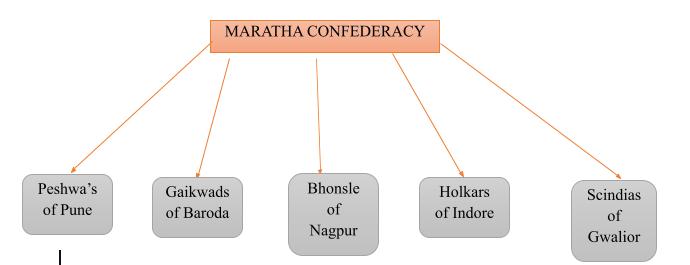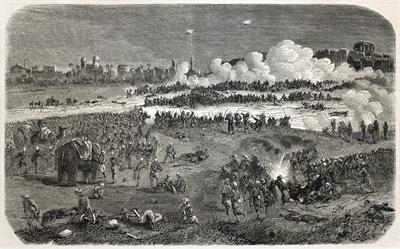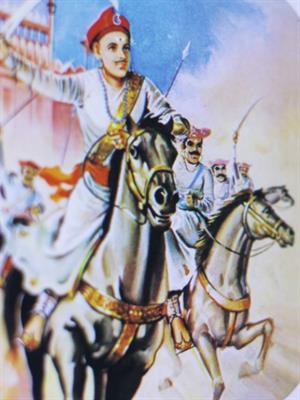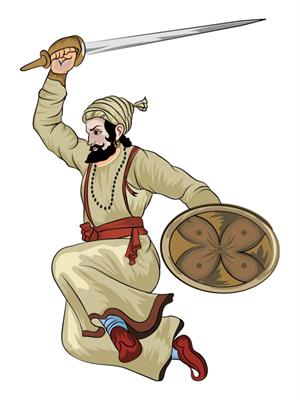
PUMPA - SMART LEARNING
எங்கள் ஆசிரியர்களுடன் 1-ஆன்-1 ஆலோசனை நேரத்தைப் பெறுங்கள். டாப்பர் ஆவதற்கு நாங்கள் பயிற்சி அளிப்போம்
Book Free DemoThe Infighting Issue:
- The Marathas emerged as a dominant power in the Western part of India after the fall of the Mighty Mughal empire. Despite the debacle they faced during the third Battle of Panipat in \(1761\), they quickly resurged back to the powers.
- The Concentration of power among the Maratha rulers was a point of concern and tussle among the other forces of Marathas. Marathas' aim to consolidate entire India under their rule was hindered by the infighting issue among fringe rulers.

- The British forces saw the lack of unity among the confederate forces of the Marathas as an opportune moment. They planned for an attack and was in a mood to capitalise and destroy the Maratha dominance.
The Tussle for Peshwaship
Anglo – Maratha War – 1: (1775 – 1782)

The Anglo – Maratha War.
- After Madhava Rao's demise, Narayan Rao claimed the Peshwaship and became the Peshwa, which irked the other claimant Raghunatha Rao.
- The Third group of contestants to the throne were under Nana Fadnavis of Pune,who asserted that the lateral son of Narayan Rao was Peshwa.
- Raghunatha Rao decided to approach the British for help, which he believed could help him gain the throne.
- The allied group of British and Raghunatha Rao defeated the Peshwa, and the Treaty of Surat was signed between the British and Ragunatha Rao in \(1775\ \)whereby,
1. Salsette and Bassein were ceded to the British.
2. 2500 army men were given to Ragunatha Rao. - The Calcutta Council of the British rejected the treaty, and Colonel Upton signed a new treaty named the Treaty of Puradhar in \(1776\ \)with Nana Fadnavis.
- Fadnavis violated the provisions of the treaty by giving a port to the French company, which angered the British and provoked them to attack Pune.
- The Battle in Pune was headed by Mahadaji Scindia, who Captain Popham defeated in \(1781\ \)(Sent by Warren Hastings).
- The Treaty of Salbai in \(1782\ \)ended the war between two forces. It was signed between Scindia and Hastings.
Implications of the War
- The BEIC retained Salsette.
- The Marathas promised no assistance to the French.
- Raghunatha Rao pensioned 3 Lakhs per year.
- Madhava Rao II became the Peshwa.
Baji Rao II and the British Plan:

Baji Rao II
- Madhava Rao II, the Peshwa, died by suicide which made Baji Rao II the son of Raghunatha Rao the next Peshwa. The fighting between the Holkar and Scindia echoed in Peshwa’s territory where the Peshwa supported the Scindia, which angered the Holkar prince Yashwant Rao Holkar.

- The Holkar king won the fierce battle who thoroughly defeated the combined forces of the Peshwa and the Scindia.
- To avenge the loss, the Peshwa sought British aid from Lord Wellesley, who made the Peshwa sign a Treaty of Bassein in 1802, and troops were sent to aid the Peshwa.
- The Holkar forces fled the town upon the arrival of the English command under Arthur Wellesley.
Anglo – Maratha War – 2: (1803 – 1805)

A Maratha Warrior
- The British considered the Treaty of Bassein as part of their Subsidiary alliance plan, which angered the other rulers who were part of the Maratha confederacy. They vowed to regain their lost independence which led to the second war.

- The British forces convincingly defeated the confederate forces of Marathas and signed separate treaties with them.
1. Treaty of Doegaon with the Scindias.
2. Treaty of Arjunagaon with the Bhonsles. - The Holkar army was not ready to surrender under British power, who continued the attack from various fronts. The attempts were routed by the Company forces, which made Maratha’s bleak.
The aftermath of the War:
- The Holkars in \(1805\ \)were forced to sign the Treaty of Rajghat.
- The Confederate forces were bifurcated to prevent future threats.
- The British became the dominant power in Western India.
The Last Shot at Redemption
Post the defeat and disrespect faced by the Marathas during the second war against the Company force; the Marathas were ready for a final assault to regain their lost glory and the empire.
PINDARIS: These are a group of people who are known for their Guerilla attack and plunder in central India. They served and assisted the Maratha forces in various wars.
Anglo – Maratha War – 3: (1817 – 1818)

The British forces decimated the confederate forces of the Marathas and put an end to the Maratha regime once for all.
Post War Implications:
- Treaty of Mansur was signed in 1818 between Holkar and the British.
- Peshwaship was abolished.
- Most of the Maratha confederacy came under the BEIC.
- The last Peshwa ruler Baji Rao II was pensioned with a huge sum of 8 lakhs annually.
- Pindaris were eliminated, and the company annexed their areas.
Reference:
Baji Rao II - PREMIO STOCK / Shutterstock.com